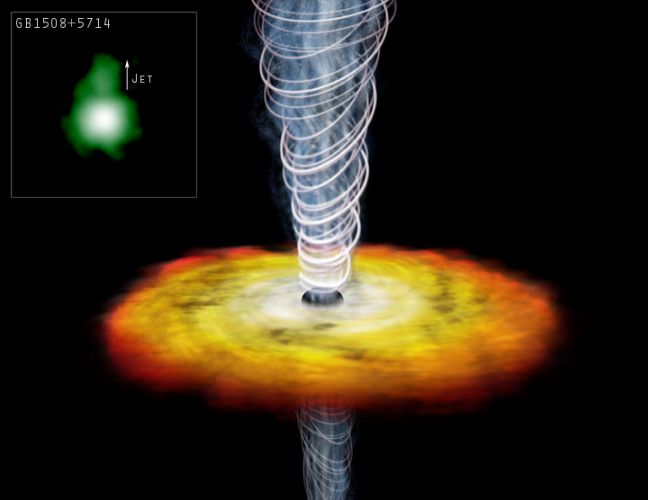Explanation: A false-color x-ray image inset at upper left reveals emission from a cosmic jet of high-energy particles, 100,000 light-years in length, emerging from quasar GB1508+5714. An estimated 12 billion (12,000,000,000) light-years away, this appears to be the most distant energetic jet in the known Universe. Astrophysical jets of many sizes seem to be produced in a range of environments where significant accretion, or infalling matter is thought to arrange itself in a disk, from contracting star-forming clouds to supermassive black holes in active galactic nuclei. Here, as depicted in the illustration, the accretion disk is thought to surround a supermassive black hole, accelerating particles to near the speed of light in two jets at right angles to the disk itself. In the case of this quasar, the jet tilted towards us is visible in x-rays as the particles collide with low energy photons from the cosmic background radiation. The collisions boost the photons to higher x-ray energies and scatter some of them in our direction.
1999 2000 2001 2002 2003 2004 2005 2006 2007 2008 2009 2010 2011 2012 2013 2014 2015 2016 2017 2018 2019 2020 2021 2022 2023 2024 2025 |
Yanvar' Fevral' Mart Aprel' Mai Iyun' Iyul' Avgust Sentyabr' Oktyabr' Noyabr' Dekabr' |
NASA Web Site Statements, Warnings, and Disclaimers
NASA Official: Jay Norris. Specific rights apply.
A service of: LHEA at NASA / GSFC
& Michigan Tech. U.
|
Publikacii s klyuchevymi slovami:
jet - quasar - black hole - rentgenovskoe izluchenie - dzhet - kvazary - chernye dyry
Publikacii so slovami: jet - quasar - black hole - rentgenovskoe izluchenie - dzhet - kvazary - chernye dyry | |
Sm. takzhe:
Vse publikacii na tu zhe temu >> | |
